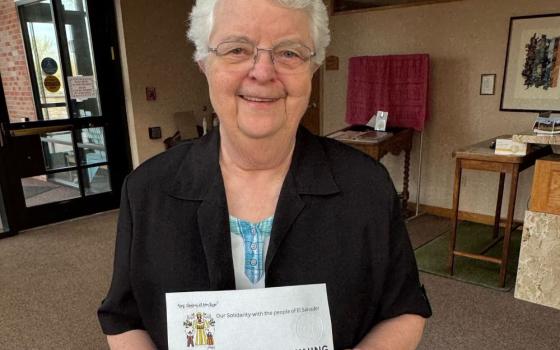In my class readings earlier this semester, I came across a myth about Ochún in the Cuban Santería Orisha tradition. If you subscribe to NCR’s print edition, you read the article in the Saints special section, “Who’s your favorite saint? NCR writers share,” that Ochún is a Yoruba deity who is worshiped with a Catholic saint counterpart in various countries in the Americas. In this particular myth, Ochún leaves her native West Africa to be with her children — West Africans sold into slavery in Cuba. When she learns that not everyone in the New World is black, she requests of another goddess, “Please make my hair straighter and my skin lighter so that all Cubans can see some of themselves in me.”
On the surface, Ochún’s action seems admirable. She made herself racially ambiguous so that everyone could relate to her. She altered herself to make others more comfortable. She is selfless. But why couldn’t lighter-skinned or white Cubans see themselves in her before? Her physical appearance was human, so why were her dark skin and wooly hair barriers to people who didn’t look like her being able to see her as human, and therefore see her as part of themselves and themselves as part of her?
This is not the first or second time I’ve used this column to ponder similar questions, and if this nation continues on its current path, I fear it won’t be the last. What is it about dark skin that makes blackness incompatible with humanity? This time I’m asking because I read the transcript of former Ferguson police officer Darren Wilson’s grand jury testimony, and at times I wasn’t sure if he was describing a man or a beast when he retells the encounter with Michael Brown that ended in Brown’s death. Wilson saw Hulk Hogan, then a demon, feet kicking up dust, and finally a creature unstoppable by bullets, grunting as it bowed its head and prepared to charge. Equally disheartening, Wilson’s dehumanization of the young man he shot goes unchallenged by the prosecution. That a black man who tested negative for cocaine and meth could morph into an animalistic threat is accepted as fact.
Since before the non-indictment announcement, I’ve called for repentance for the demonization of blackness that Christianity perpetuated. I’ve called for white men to see themselves as equal to every other human being. Since the decision I’ve marched with hundreds of others in Louisville and thousands around the world who want justice, action and change. We know structural inequality is deeply entrenched and must be dismantled, and we know to demand accountability from an inequitable legal system. But how to change hearts and minds stumps us.
I think that for people who profess to be Christian, change lies in the opening example’s message, that is, how we see ourselves and others in the Divine and the Divine in them. If demons and Jesus cannot coexist, perhaps one way to overcome the demonization of blackness is to challenge our images of Christ. I’ve said previously that images of Jesus as a white man help reinforce the message that whiteness equals perfection and that a “sweet, black dreadlocked Jesus” proves there is good in me.
But this image of Jesus with skin and hair like mine does more than demonstrate good; it reveals the existence of holiness, perfection and divinity in black skin. And since Jesus straddles godly and human realms, his image as a black person reveals black humanity, too. By reimagining the Christian God and Christ as men of African descent, for centuries African-American theologians have, to varying degrees of success, rehumanized blackness in the face of churches calling black skin the curse of Ham and the government declaring each slave three-fifths of a person. But it has been a message largely aimed at black people. I think it’s time for every Christian to be able to see her- or himself in “sweet, black dreadlocked Jesus.”
In fact, it’s past time. In 1999, Notre Dame de Namur Sr. Wendy Beckett selected artist Janet McKenzie’s painting “Jesus of the People,” as winner of NCR’s art competition calling for “a new image of Jesus at the Millennium.” I remember stumbling across McKenzie’s painting online back then, probably searching for something for my art history class, and being startled to see an androgynous-looking figure with a crown of thorns on what I took to be her brown head. In stark contrast to the images of Jesus in my Western art history classes, my grandmother’s house, and the church I grew up in, this Jesus possessed big lips and a wide nose. She looked like someone I knew. It’s been a long time, but I remember reading that McKenzie, who is white, had a biracial nephew or perhaps grandchild, and she wanted that relative to be able to see himself in images of Jesus. A Google search for McKenzie today tells me her goal as an artist is to include “groups previously uncelebrated in (Jesus’s) image especially African-Americans and women.”
It also tells me she received death threats alongside praises for her NCR recognition.
I mention this to acknowledge change isn’t easy. People guard their religious beliefs fiercely. They are a part of our identity. They are a part of where we come from. But if where we come from continues to be exclusive, to demonize and dehumanize, we can’t expect to go anywhere else.
[Mariam Williams is a writer born and raised in Louisville, Ky., where she's received numerous arts awards. When not working in the field of social justice research and taking graduate courses in women and gender and Pan-African studies, she blogs at RedboneAfropuff.com. Follow her on Twitter: @missmariamw.]
Editor's note: We can send you an email alert every time Mariam Williams' column, At the Intersection, is posted to NCRonline.org. Go to this page and follow directions: Email alert sign-up.



